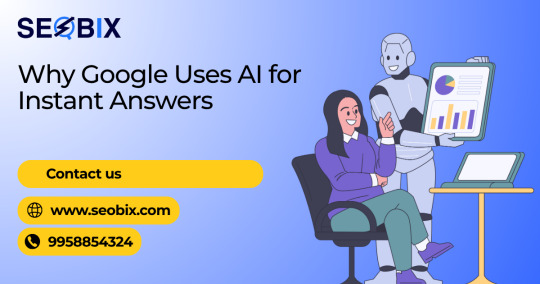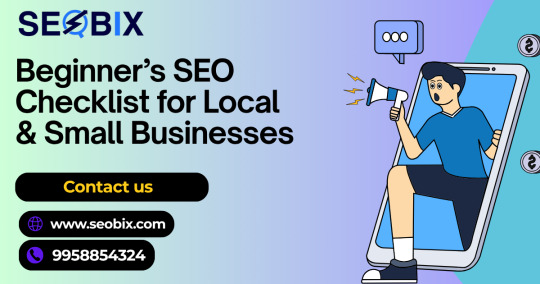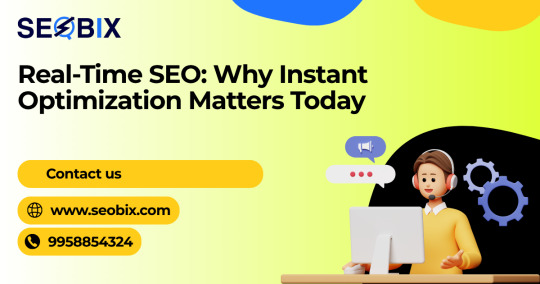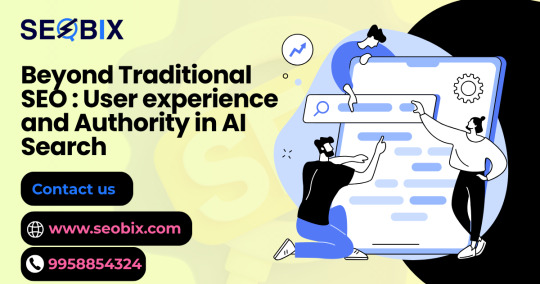Don't wanna be here? Send us removal request.
Text
Do Facebook, Instagram, and LinkedIn Help You Rank on Google?

Social signals themselves are not direct ranking factors in Google’s algorithm, the influence these platforms have on SEO directly and indirectly is massive and only increasing. It won’t immediately get your LinkedIn page to rank on Google’s first page but it can certainly influence how your brand appears, is searched for and interacted with, across the web.
Link between Social media and SEO
Google has been pretty clear in publicly declaring that social signals – likes, shares, comments, etc. Yet, social media activity comes with a small change in initial conditions that impacts the performance of your content.
Every time your content is shared on Facebook, Instagram, or LinkedIn, it earns you access to a larger audience, exposes your brand to a wider range of potential customers, and brings more people to your site. These visitors aren’t just numbers , they interact directly with your content and spend more time on your site before potentially linking back to it in the future from their own pages.
Social media is a powerful way to establish authority and credibility.
The greatest advantage of platforms such as LinkedIn and Instagram, for example, is their ability to build brand awareness and authority, which boosts SEO. When someone searches your brand or business name and consistently sees high-quality, relevant brand results on each of your social profiles, you’re boosting your trust signals.
Facebook takes over in local and community-driven spaces. Instagram increases product discovery and brand recall.
The clearer, louder, and more consistent your brand is over these various platforms, the more opportunities there are for Google to identify you as an authority, particularly when those signals are paired with solid on-page SEO.
Social content equals to linkable exposure
Of course, not every backlink is item of search . A viral tweet, a trending LinkedIn post, or widely-shared Facebook article can help grab the interest of bloggers, reporters, or industry influencers in search of something to find or quote.
Those mentions and search volume , become backlinks to your site, and backlinks are still one of Google’s most long-standing and trusted signals of authority. So even though the share itself is a strong ranking factor and it creates a visibility too. This is why brands consider tools like Seobix to track backlink growth along with keyword visibility to tell them how content behaves no matter where it originated.
Shifting passionate traffic from social to search
This is a signal that search engines will pick up on, and it might warrant your ranking being decreased.
If a person clicks your link , then takes time to read that particular post you shared
Click on a few other pages on your site or check out your services, that’s all great engagement through Clicks.
That action signals to Google that your content is useful, something that leads to better rankings over time.
Those visitors will eventually begin to seek your brand out directly. Branded search terms are a pretty good indicator of trust and relevance, and Google looks for trust and relevance. So even if the traffic is initiated from a social referral, it almost always eventually has an impact on search intent.
Conclusion
Facebook, Instagram, and LinkedIn assist you rank on Google? The answer directly. They supercharge your content, increase your reach, establish access to links, influence how people engage with your brand. Having an intelligent SEO tool like Seobix can help you get a broader view. It completes the picture from your social appearance to your keyword rank to where traffic is coming from, providing a look at how well your content is performing outside of search.
#SocialMediaMarketing#OnlineVisibility#SocialMediaSEO#search engine optimization#SEO#social media seo#SMO
0 notes
Text
The Role of Backlinks in Boosting Page Authority

In the fast-paced world of SEO, Page Authority is an important pattern in understanding the ranking strength of your web pages within search engine results. By knowing what backlinks do, you can work smart to win those all-important backlinks and improve your website’s visibility and authority.
What are backlinks and their importance
Backlinks, also known as inbound links, are links from one website that point to another site. Think of them as online votes of confidence. Search engines, such as Google, look at these votes to determine the authority and relevance of your content.
Not all backlinks are mined equally. A link from a trusted website in your niche carries far greater value than a link from a spam based or irrelevant site. This increases the Page Authority of your page, because high-quality backlinks prove to search engines that your content is trusted by other high-credible sources, which increases the chances that search engines will rank your page higher.
How Backlinks directly affect Page Authority
Page Authority is a score that predicts how well a single page will perform based on its chances of ranking highly in search results. Backlinks are among the most important signals incorporated in calculating this score. The more trusted and relevant the backlinks pointing to your page are, the stronger your Page Authority grows.
Backlinks help you gain actual visitors to your site in addition to affecting how search engines observe your site. When users go through these links, they increase the dwell time, they go to more pages.
Better Quality over Better Quantity
The truth is, search engines have never been smarter when it comes to finding spammy or off topic links. These types of backlinks do more damage to your rankings than good.
Tools such as Seobix provide a valuable process to you, analysing your backlink profile, helping you to identify strong links, and even uncovering opportunities where you can gain high, quality backlinks. By smartly keeping tabs on your link building efforts with Seobix, you can eliminate unexpected risks.
High-quality backlinks are essential for improving search engine ranking
Here are some effective strategies :
Create valuable content that others want to link to.
Reach out to industry influencers and ask for backlinks.
Guest post on reputable websites within your niche.
Utilize social media to promote your content and gain visibility.
Monitor your competitors' backlinks and identify opportunities.
Cultivating relationships with influencers, bloggers, and relevant industry websites is another way you can earn high-quality backlinks.
Constantly refreshing and updating your current content is a good way to keep it relevant and make sure it’s appealing to new backlink opportunities. With Seobix, you can track the performance of your underperforming pages, so you know where to focus your content updates and backlink outreach.
Conclusion
Building quality backlinks is an essential part of building your Page Authority and increasing your search ranking. They’re not simply links. They’re a vote of trust, credibility and relevance to search engines. By putting quality over quantity and employing smart, effective SEO tools such as Seobix, you’ll create a high backlink profile that ranks your pages to the top.
#seo marketing#digital marketing#digital growth#seo services#page authority checker#Backlinks#search engine optimisation services#onpage seo
0 notes
Text
Why Online Reviews are crucial for local SEO success

Reviews are one of the brightest local SEO signals out there right now.
After all, local search isn’t merely an exercise in visibility. It’s an exercise in credibility, both to customers and search engines alike. Further still, how your audience interprets and judges your brand across the web is a key determining factor of if your business will be shown in Collaborative Google’s local pack, AI Overviews, and “near me” queries.
Why Reviews Matter for SEO Rankings In Search Engines
Search engines have come a long way from just counting keywords. User-generated content signals, reviews in particular, are more tightly controlled than ever in Google’s algorithm to determine which businesses should be rewarded with appearances in coveted above the fold positions. Specifically, if your business has a higher number of reviews, a higher positive sentiment in those reviews, and more recent activity, then Google recognizes that as a strong signal of relevance and trust.
Put another way, the better your reviews are, the better your position on the SERP grows.
That’s why platforms like Seobix have quickly become the solution of choice for local businesses. They keep you on track by monitoring review activity across all platforms, while surfacing important trends, sentiment trends, and keywords trends in customer reviews. This allows you to make sure your SEO strategy is mirroring what actual customers are saying about you.
Social proof and decision-making are tied Together
Today, online reviews are the new word-of-mouth. People believe when a company has 50, 100 or more customer reviews, it gives And it’s not only because of rankings. Reviews majorly impact purchase decisions. That’s why so many businesses these days positively push satisfied customers to leave reviews immediately after a transaction or visit.
Seobix makes this part of the process more automated and streamlined by letting you know the ideal times to ask for reviews and tracking what platforms are most important in your industry or nearby area.
Reviews Helps You Stay Relevant
Search engines are always looking to display the most active and relevant businesses to their users. That’s why a business with newer reviews will almost always beat a competitor with older stats—even if they have a greater overall number of reviews.
Google’s AI searches for new activity, which means how frequently customers are posting new reviews, how fast a business is replying to those, and are customers talking about your brand-new offerings.
With Seobix, companies can monitor and ensure review accuracy while receiving recommendations to maintain an engaged stream. This can be via follow-up messages, email or SMS review requests, or even localized content ideas that foster community dialog.
Responding to Reviews Builds Trust : Helps Your SEO
Replying to reviews : particularly the negative ones , demonstrates to both potential customers and search engines that your business is invested in their experience. Your responses contribute to a more in-depth picture of your enterprise, providing further keyword context and increasing your local profile in search.
Search engines reward businesses that are easy to contact and if you reply with just an acknowledgement like “Thank you for your feedback”, it’s better than nothing and goes a long way.
Seobix suggests personalized response templates and alerts you when a review may be particularly valuable , or damaging : to your online reputation.
Conclusion
Online reviews are no longer just a means for customers . They’ve become a crucial part of your local search engine optimization strategy . Whether it’s making them more aware of your offerings, establishing brand authority, or boosting sales, reviews play a critical role in each stage of a customer’s decision-making process.
With intelligent solutions like Seobix leading your audit plan, you’re not just soliciting stars , you’re creating a recognizable, reputable and authoritative brand that competes within your local market.
#LocalSEO2025#LocalSearchTrends#SEOforBusinesses#MobileSEO#LocalMarketing#GoogleMyBusiness#local search optimization#google ai overview
0 notes
Text
Why Google Uses AI for Instant Answers

Search engines are not just getting better, they’re fundamentally different than even a few years ago. Many things are different for one, Google no longer lists websites. It learns, it adapts, it predicts , more like a person than you might expect. The most significant shift in recent times is Google’s new found power to provide immediate answers across the board with generative AI. This shift has transformed not only how we search, but how we read and how content is developed on the web.
Keeping Up with the Demand for Speed
Google’s artificial intelligence can interpret the intent behind a user’s question or query, search through millions of pages, and provide an accurate, immediate response , in many cases, right at the top of the search results page.
This rapid response is called an AI Overview. It’s less time-consuming, it’s more intuitive and it provides users assurance that they’ve located what they’re looking for. The more useful the answer, the longer people are likely to spend with Google. That’s why the platform is heavily investing in AI to continue being useful, relevant, and quick.
Getting Inside the User’s Mind
The second big reason Google leans on AI is to better determine search intent. It focuses on the long-term view. AI allows Google to determine not only the words someone typed but also what they intended to convey.
Take someone searching for “best laptop for students”, for instance, Google understands that they’re not just looking for a list. They’re likely looking to see side-by-side feature comparisons, read reviews and customer feedback, discover expert recommendations, all in a single glance. The AI reads the lines, and gives a deeper and more useful response.
Platforms like Seobix are goes beyond telling you which keywords to target. It really guides you to writing content that addresses the person behind the search.
Presenting technical , in more easy way
AI further allows Google to take complex subjects and breaks them into easy to understand explanations. Not every user is a technical expert, and most people simply want a quick and easy answer to their question. Google AI goes beyond general content creation, taking trusted, comprehensive content and re-writing it in a more human, conversational format that’s easier to digest and understand.
This makes it easier for all people to engage with the data, regardless of their familiarity or levels of understanding. Platforms like Seobix promote diverted users away from the smoke and mirrors and towards clarity, pursuit of intent, and simplicity in every piece of content you create.
Changing the way we search for the better
Google’s latest mission is to make search feel more human, fluid, and smart to the users. AI enables this by personalizing the experience based on user intent, anticipating needs through learning from search patterns, and continuously evolving.
Seobix serves efficiently in the background to make all this possible. It helps you get content ideas that are in line with Google’s current best practices. This isn’t about gaming the algorithm. It’s about arming you with the information you need to produce content worthy of selection by AI as the best response.
Conclusion
So Google is using AI to go beyond the blue link to provide immediate answers because users expect results that are more intelligent, immediate and helpful. It’s not enough to just demonstrate websites, it must truly address problems and improve quality of life. To all the future builders of this new ecosystem, it’s the same hub approach that requires you to think less like a search engine and more like a friendly librarian.
When your content is easy to understand, to the point, and written for the user, Google’s AI can have confidence that your content is the right one. Like powerful platforms such as Seobix, you can create content that’s not only optimized for search but for the future.
1 note
·
View note
Text
From Keywords to Conversations: How Search Has Evolved

Fast forward to 2025, and search is no longer about keyword matching. It’s about understanding human conversations, context, and intent. Google doesn’t just crawl web pages anymore ; it thinks, it interprets, and it even responds. What we’re seeing is the shift from keyword based SEO to conversation driven search.
The Keyword Era: When Simplicity Was Enough
Back in the 2000s and early 2010s, SEO was largely reliable . If you wanted to rank for “best pizza in Delhi,” you just needed to include that phrase , in your title, your heading, and your body content — a few too many times. The system worked because search engines weren’t smart enough to question the user’s true intent. They only saw the literal text.
But the problem with keyword stuffing and mechanical optimization was that it never served the user. It served the algorithm. People landed on pages that didn’t quite answer their questions, didn’t speak their language, and didn’t understand what they really meant.
From Phrases to Intent: The Rise of Smarter Search
As AI became more integrated into search engines, the game changed. Google’s updates ; from Multitask Unified Mode and now SGE (Search Generative Experience) — have all been steps toward one goal: understanding what users are trying to say, not just what they’re typing.
That’s why, in 2025, your content needs to think like your audience. Instead of matching keywords, you need to mirror conversations. Your blogs, product pages, FAQs , all of them should sound like they’re part of a helpful chat. Because that’s how AI is processing them.
Platforms like SeoBix have quietly adapted to this shift. Rather than offering outdated keyword tools, they provide deep insights into how people actually phrase questions, how search engines interpret them, and how to build content that fits naturally into those evolving patterns.
Voice Search and AI Assistants Changed the Tone
Another major catalyst in this shift has been the rise of voice search and AI-driven virtual assistants.
Search engines had to evolve, and so did SEO strategies. Now, content that ranks is the content that converses. It reads naturally, anticipates follow-up questions, and creates a seamless flow from one idea to the next.
With SeoBix, creators don’t need to guess what that flow should be. The platform analyzes conversation trends, user behavior, and intent-based search journeys to help you craft content that’s not just findable, but meaningful.
AI Overviews and Zero-Click Results: New Rules, New Reality
In today’s search results, users often get what they need before they click. AI Overviews, answer boxes, and featured snippets now dominate the top of the page. That means your content doesn’t just need to rank — it needs to be concise, direct, and instantly valuable.
To show up in these spots, you have to structure your content like an expert yet make it feel like a casual explanation. That’s not always easy, especially when you’re dealing with complex topics.
This is where platforms like SeoBix prove their worth. They help structure your messaging for AI clarity without losing your brand’s voice or readability.
Search Today Is a Dialogue, Not a Directory
Search is no longer a static query that pulls up a list of links. It’s a dynamic dialogue , a back-and-forth between human curiosity and machine understanding. And the businesses that thrive in this environment are the ones that don’t just talk at users. They listen. They respond. They adapt.
SEO in 2025 isn’t dead. It’s just smarter, more human, and deeply integrated with the ways people speak, not just how they search. And if you’re using tools built for the old web, you’ll miss out on the new one.
Conclusion
If you want your brand to stay relevant, your content must go beyond keywords. It must feel like it’s part of the conversation already happening in the user’s mind.
With platforms like SeoBix helping you bridge the gap between AI understanding and human intention, you’re not just optimizing for search engines , you’re creating content that genuinely connects.
Because in the end, great SEO isn’t about chasing algorithms. It’s about joining the conversation.
#keywordresearch#keywordranking#marketingstrategy#keywordresearchtool#seo#ai overview#Keywordbasedseo
2 notes
·
View notes
Text
Beginner’s SEO Checklist for Local & Small Businesses

In our digital-first world, having a presence online has gone from being a nice-to-have to an expectation. For small and local businesses, SEO is the fortune of possibilities. If you’re a beginner, SEO might seem like a complex maze of confusing technical terms.
Optimize your Gains and purchases
Just like any local business, your Gains and purchase is your online storefront. Ensure that your profile is 100% complete ; everything from your address and business hours, all the way down to your photos and service categories. Merely having a profile isn’t sufficient. To continue improving this series. Upload new photos often, reply to reviews, ensure your information is current. Active, verified businesses are what Google cares about most. This is a step many businesses overlook. This is frequently what makes the difference between the seen and the unseen.
Tactics to Optimize Your Website for Local Searches
After all, your website is the face of your company’s digital identity, and it should reflect the language your prospective customers and partners use. That's going to require you to use these location-based keywords organically wherever you can within your content. The content and structure of your website plays a huge part, as well. That means each service needs its own page, with detailed content that answers actual questions. Tools such as Seobix simplify this by breaking down what local keywords your competition ranks for that you can strategically add to different pages with a natural flow.
Mobile optimization shouldn’t be an afterthought
Consumers who are looking for a local business are primarily on mobile devices. In this reality, if your site doesn’t work on mobile, you’re already losing the game from the get-go. From Page Vitals loading speed to Button Clickable that’s every second and tap counts. When it comes to user experience, a mobile-optimized site makes it easier for visitors to find what they’re looking for, even when they’re on the go and multitasking.
Technical issues such as Mobile Usability errors can be flagged by Seobix before they start affecting your performance.
Produce Trustworthy Communications At The Local Level
Genuine and relatable is what wins the day Real, simple truth-telling content that reflects an understanding of your customers’ needs will really resonate. Tell authentic local stories, make a clear case for your services, and introduce your team or satisfied customers. Content that passes the test of authenticity isn’t just good for humans — it’s precisely what Google’s generative AI wants to provide in results.
Plus, optimizing your pages with FAQs will position you to show up in AI Overviews and voice search results, which will be increasingly relevant in 2025. With Seobix, you can find out which of those local questions are currently the most popular so you can answer them first before your competition even knows they exist
Response to Feedback
On the consumer side, online reviews are the new word-of-mouth. They’re not merely social proof. They feed directly into your local search rankings. Customers will respond positively to your request, and some will even post happy reviews directly on your Google profile. Answer every review , good or bad ; with a level head and a respectful tone. It demonstrates that you value your audience’s time, and that’s more important now than ever to both readers and algorithms.
Seobix can monitor the effects of reviews on your local presence and provide actionable recommendations to further boost engagement in a natural, non-spam based manner.
Measure What Matters
SEO is not a set it and forget it operation — it’s a repeatable process of tracking, refining, and expanding. Google Search Console and Google Analytics are free tools that provide powerful and helpful insight into how people are finding you. For those starting out, they can be daunting. That’s where a solution such as Seobix can make all the difference. It makes SEO reports easier to understand, tells you what works, and recommends the next steps you need to take, keeping you on the path to continual improvement without drowning you in data.
Conclusion
Local SEO is the most effective use of their marketing dollars for small businesses looking to gain traction online. It’s not about finding an angle to outshout the larger organizations .
it’s about being where the conversation is, having the right message and tone, and being there over time. Leave the heavy life to the Seobix team, while you concentrate on what you do best ; running your business, and serving your customers!
0 notes
Text
Can ChatGPT Write SEO-Optimized Blogs Better Than You?

Blogging is no longer about idea sharing from content's perspective. It is a calculated name game for words, structures, and strategy for visibility. And with AI entering the equation with the likes of ChatGPT, many creators are wondering-if an AI can actually write a blog better than a human.
New Face of Content Creation
Artificial intelligence has truly changed the way blogs are written and optimized. ChatGPT-like tools have turned the magic by generating clean content that is readable and SEO-appropriate within seconds. For marketers and small-scale entrepreneurs, it seems nothing less than a realization-from denying a blank screen to grasping the precise keyword placement that AI has fast-tracked.
But Where’s the Soul?
To give speed properties and a structure to an activity, it somehow lacks personality. ChatGPT does not relate an experience. It knows no feelings. It will never add a perspective grounded in life. Thus, it can write, but it cannot empathize like humans do. Such real connection is still the nucleus of excellent content.
The Strategic Edge of AI in SEO
Cutting-edge content creation rarely learns beyond flair and function. Blogs must stay in First Dynamic Trends that attend search behavior, keyword dynamism, and user intent. This very thing is the part of excellence for AI. It must legally act with intelligent SEO tools, and AI will not simply write-it writes with a purpose.
These platforms keep evolving in an attempt to blend AI writing with SEO intelligence, and thus the creators keep creating content that performs. There are software that help creators even before the first sentence is written: keyword building , trend tracking, and competition analysis.
Why Human aligned with AI Wins
The best content being currently produced is collaborative. AI guides the structure, tone, and rhythm ; human input is what breathes life into it. Thus, when a creator blends his/her insights with those from AI-powered SEO platforms, the blogs produced are high-ranking, high-value blogs that bring in quality and performance.
The Hidden Power of the Right SEO Tools
Considering the AI in writing is only as mighty as the ecosystem it resides in. The platforms that keep SEO insights, live ranking analysis, and AI-generated suggestions in a big pot are now ever so changing the nature of the game. They do not merely help you in writing; they help you write what matters.
Conclusion
For the creator working alongside AI as a co-pilot, who harnesses strategic SEO platforms, there is no compromising answer: AI will not replace you ; it will put you on a higher position.
Modern-day blogging is not man versus machine-it is man empowered by machine. And when you are equipped with blended tools of AI writing and high-powered SEO insights libraries, like the ecosystem built into platforms as Seobix, you will not just compete; you will dominate.
#Gemini25#GPT4o#GoogleVsOpenAI#ArtificialIntelligence#AIComparison#aivshuman#keywordresearch#humanvsai
0 notes
Text
Real-Time SEO: Why Instant Optimization Matters Today

Real-time SEO isn’t just a trend anymore. It’s a necessity . Blogger, brand or business , it doesn’t matter ; instant optimization is your best secret method to break through the digital trends and own the moment in today’s ultra-competitive digital environment.
The game has changed
Google’s algorithms have never been faster, smarter or more responsive. Thanks to real-time indexing, search engines can crawl and rank content in as little as a few minutes. That’s because your content should be optimized from the moment it’s published, or ideally even before.
Let’s be real, even if you do have a good post in the works, if it’s not perfectly optimized from day one, you’re probably not going to drive much traffic because your competitors got there first.
Why Speed equals to Visibility
The quicker your content is found, indexed, and ranked, the better your opportunity to ride the initial wave of trends. Whether that’s an announcement in the news, something new they’re launching, or a new blog post that’s all the vital pattern , timeliness matters
Popular keywords and viral subjects rarely last long. That’s why if your content isn’t optimized the second it’s released, you can potentially miss the whole wave. Unlike traditional SEO, real-time SEO is not constant, it’s fast, too. It demands quick actions , automation, and intelligent SEO tools.
Trial and Error wont work
This is where SEO platforms like SeoBix come in. Seobix empowers content creators to optimize content immediately with real-time insights and AI suggestions.
By not adapting to what AI-backed real-time optimization can enable with a platform that allows your content to adapt in real-time to the very things users , are looking for today.
The Role of SERP Features & AI Overviews
Between AI Overviews, our own featured snippets, voice search, and zero-click results, They are clearly getting the wave of the future, where increasingly, visibility is slowing down like a downward 30-second countdown clock.
Real-time SEO allows you to sharpen your content structure and tone to take advantage of these constantly changing SERP features. If you aren’t real time optimized, your chances of even showing up in these coveted spots are slashed.
Data is Only Useful When It’s Immediate
With real-time SEO, you have this control placed in your hands. If you have existing content that’s flopping, a tool like Seobix can help recommend quick wins, whether that’s optimizing your title tag, adding more content, or shifting focus to a new keyword.
That kind of speed and accuracy isn’t just brilliant — it’s the craving in the SEO battlefield of 2025.
Content Freshness is a Ranking Signal
Google likes new, updated content and they’re the biggest search engine in the world. Because if your competition is re-optimizing their blogs, web pages, and product descriptions in real time and you’re not, day by day, you’re falling down the ranks.
Here’s the positive part. With the right tools, keeping things fresh doesn’t have to be a challenge. Platforms like SeoBix enable you to automate the process of breathing life into expired and found content so that content continues to work for you, and you don’t have to do it all by hand.
Real-Time SEO is the New trend
SEO is no longer about who earned it best , it’s about who deserved it first and who can continue to deserve it better, in an ongoing real-time manner. Whether you’re an eCommerce brand promoting flash sales or a blogger writing about live events, on the fly optimization will cut it , or get you cut out.
Conclusion
In an age that’s becoming increasingly more real time, where algorithms are adjusted in the moment and real time SEO isn’t just optional , it’s essential. Our new reality will see the winners being those that can work as quickly, and out shine their competition.
If you’re looking to take that real-time shift, look for tools such as Seobix , platforms built for real-time SEO, keeping your content visible, relevant, and always ahead of the competition.
0 notes
Text
Optimization for voice search means natural, question-based keywords in 2025, having local SEO, and site speed issues resolved, along with a mobile-friendly site. Providing clear and concise answers with structured data (for example, schema markup) will help voice results visibility. Getting featured snippets and ensuring content means the intent of the user is also a must. Content should be updated according to search trends to remain relevant. Give voice searches success with simplicity, speed, and that ever-so-important conversational content matching how people actually speak.
#GoogleIO2025#VoiceSearch#VoiceSEO#Gemini25#AIMode#GoogleTranslate#AgentMode#SEO2025#DigitalMarketingTrends#VoiceSearchOptimization
0 notes
Text
AEO vs. SEO: What's the Difference & Why It Matters in 2025

The world of digital search in 2025 is a radically different place. Since Search Engine Optimization (SEO) has been the jewel in the crown of digital marketing , the key to getting your website seen at the top of search engine result pages (SERPs) and ultimately, driving that critical organic traffic.
Understanding the differences, similarities, and interrelated collaborative relationship between SEO and AEO is no longer nice to have, it’s a need to have for any brand that wants to not just be alive, but grow and flourish in this new AI-driven landscape.
SEO : The Cornerstone of Your Online Presence
Traditional SEO, the way we’ve practiced and performed it for the past 2 decades, is heavily focused on optimizing your website to rank in organic search engine results. Its end goal is to get clicks and drive people to your site.
That’s because SEO is all about capturing those users, initially in the research phase, seeking information, or researching/considering/deliberating between options at each stage of the process , and drawing them to your web asset.
AEO: Featured & Hidden Snippets
Answer Engine Optimization (AEO) is a newer but rapidly emerging discipline born from the criteria of AI search. Think : AI Featured Snippets, AI knowledge Graphs, AI rich snippets, AI knowledge panels, AI assistants like Siri and Alexa, and of course AI chatbots giving users answers right there on the SERP. It’s AI that’s going to deliver the direct answers someone’s looking for, without them ever having to click to your website, just delivering them right in the search engine.
It means explaining things in a way that puts clarity and directness first, and maximizing AI’s ability to dig into and summarize AI’s most relevant information.
Intent Implementation
SEO is just the practice of attracting users to your website to then guide them into that deeper content that can be long-form and detailed , crafted for good old-fashioned Browse.
AEO are all focused on providing immediate, direct, no-nonsense answers directly on the SERP, most often in the shape of concise, highly structured content specifically created for the purpose of AI utilization.
Where SEO can often measure success in increased organic traffic, better rankings, and more conversions, AEO focuses on confusing, misleading metrics such as snippet capture rate, voice answer mentions, and AI referred count all blending in “zero-click” interactions.
AEO thrives on content presented in clear Q&A formats, lists, tables, and through the use of structured data (schema markup), making it easy for AI to interpret.
Why This is Important in 2025
Users are increasingly expecting more direct answers right away, which inherently decreases the chances of them clicking several organic listings. This “zero-click” phenomenon is as hard for traditional traffic demand models to imagine as it sounds.
It’s an amazing opportunity for AEO. Brands gain credibility by being the answer AI spits out for those questions. Even if they don’t ever click through directly, simply from consistently appearing with the most useful, most relevant information builds incredible trust and that critical, top-of-mind awareness.
The Symbiotic Relationship : Differences
AEO doesn’t replace SEO ; it enhances and supercharges it. Strong SEO fundamentals are still the bedrock upon which effective AEO is built. AI models still keep crawling and feeding off the rest of the web, and crawl smartly prioritizing content from websites that establish E-E-A-T (Experience, Expertise, Authoritativeness, Trustworthiness).
That’s why a SEO strategy is essential. It prepares your content to be in contention when the time comes for AI to select which content offers the most direct answers.
In 2025, the most successful digital strategies will be the ones that achieve these things without creating chaos between one and the other. They’ll use SEO to build that broad net of visibility and authority, and then use AEO to claim those critical, high-value, direct-answer moments.
Conclusion
Determining which legacy keywords continue to drive traffic versus what AI-powered conversational queries lead to an immediate response and then redirecting your content to serve both is a creative balancing act.
Here’s where a smart SEO tech platform should be your unfair advantage. That’s why platforms like seobix specifically allow you to track the keyword rankings you’re familiar with, it empowers you to track your brand’s presence in AI Overviews and direct answer answer box snippets.
Seobix get you first of all to identify content gaps for SEO and AEO, act as the AI spotter on how AI is interpreting your content today for summarization and in time provide the full comprehensive data that your brand will need to be found, trusted and cited in the search ecosystem of 2025.
#SEO#SEOTips#ContentMarketing#SearchEngineOptimization#DigitalMarketing#SEOStrategy#SEOContent#aeo#answer engine optimization#AEO2025#SEO vs AEO#aeo services
0 notes
Text
In 2025, winning out with FAQ schema and long-tail keywords is going to come down to really understanding user intent. Because they are more specific and there’s less competition, long-tail keywords (usually 3+ words) bring in the most qualified traffic.
Combining these with FAQ schema gives search engines more context to work with and the potential to display your content as rich snippets, or “AI Overviews,” answering users’ questions right in search results. Target natural, question-style long-tails and make sure your FAQ content appears in a user-friendly way on page. Be brief, get to the point, and provide value by answering users’ questions.
0 notes
Text
What Tools Help You Track SEO Results Better in 2025?

Particularly with the ever-increasing influence of AI on every aspect from ranking to user journey, the world of SEO is evolving faster than ever before. So, just what tools do we need to begin using for better performance tracking in SEO 2025 and beyond. It’s really a shift towards being more interested in measuring brand impressions, brand power, multi-touch customer journeys as opposed to just keyword ranking positions.
Core SEO Platform Development
Semrush and Ahrefs continue to be the regular traditional all-in-one SEO tools, they too have been challenged to pivot. These economic powerhouses are installing grade-crossing-avoiding, advanced artificial intelligence, beginning in 2025.
They’re helping you figure out what you should be targeting, of course, but not just any keywords—new keyword opportunities based on AI trends , conducting an inventory of your content to make it more AI-friendly (content AI can easily digest, aka top-notch readability and accuracy for AI Overviews), and even providing you visibility into your competitor’s moves as they adjust to the new AI-driven SERP, rather than simply tracking your keyword rankings.
Their real power comes from their all-in-one suites for technical SEO , content optimisation, back link analysis and good old-fashioned rank tracking.
Tracking AI Overviews and Zero-Click Visibility
The advent of AI Overviews and similar direct answer features has led to more than half of searches being “zero-click.” This is where specialised or advanced tools have an advantage. While Google Search Console does provide limited impression data, new AI SEO tracking tools have begun to appear that monitor your visibility specifically in these AI-generated snippets.
New tools exist to measure citations: how often your brand or content is cited in AI Overviews, without the ability to track a click directly created.
They help on SERP feature visibility. Beyond just classic rankings, these next-gen tools find out if your content is showing up in featured snippets, “People Also Ask” sections, knowledge panels and, best of all, AI Overviews. They dive into conversational search performance: with voice search and AI chatbots rising in popularity, some tools are beginning to measure how your content performs in these natural language queries, measuring complete prompts as opposed to just keywords.
Multi-Touch Attribution & Advanced Analytics
To Google’s credit, Google Analytics 4 (GA4) has moved in a direction of offering attribution models that are more flexible and not solely focused on last-click, leveraging machine learning to distribute credit across every touch point.
For a true deep dive, though, custom platforms are significantly surging in popularity going into 2025. That’s what makes it all the more critical to marketers to even know the true full impact of SEO, not just the last click.
Maximising the Value of First-Party Data and More
Regardless of any specific niche SEO platform, the importance of first-party data is at an all-time high. Customer feedback tools (such as post transaction surveys) and direct integrations are becoming the new frontier for figuring out how organic search fits into the greater customer life cycle. Particularly when paired with predictive analytics, these tools help marketers understand where search is going before a user even gets there, allowing for more proactive approaches to SEO.
Bringing clarity and focus amid the chaos
In this fast-paced environment, an all-inclusive platform that absorbs all of these different tracking needs is worth its weight in gold. This is precisely why seobix is going to be your favourite SEO tool in 2025 and beyond. Where other tools do a better job at one, seobix gives you the tools to understand it all. It lets you slice up complex multi-touch-attribution paths, showing you how organic search drives a conversion and not just a click.
Conclusion
Seobix allows you to not only measure how well your keywords are performing as the SERP features evolve, or what your competitors are doing in this new AI-based world, but eventually connect your SEO efforts right to tangible business outcomes.
It’s less about the specific individual tactics and way more about how those dots are connected to an overarching strategy to ensure every single ounce of SEO intelligence proactively pays off. This strategy is perpetually putting you several steps behind competitors in the race to get found first.
With seobix, it’s not just about tracking — it’s about driving strategy confidently
0 notes
Text
How Reviews and Comments Help You Rank Higher on Google

Optimizing your website and adding extra links are no longer the main focus of SEO in 2025. It means building trust with users, connecting with them in meaningful ways, and learning how they look for and deal with your web content everywhere online. There are two key factors that are surprisingly important in this new era. Reviews and comments will help, and remember to also check where your visitors are located.
User content greatly helps SEO.
Now, Google analyses the entire experience a person has when using the internet, not just the page they visit. Each review or comment on your site or elsewhere proves to search engines that your site is lively and genuine. Google’s algorithms are now designed to notice and value these interactions when they are: relevant, beneficial, and similar to what is presented on the page.
A review that contains the keywords you want without seeming unnatural (like “I was able to save ₹10,000 with this budget travel app”) can increase your site’s SEO for those keywords. And lots of comments that show people are really participating? That is a sign of how much users trust Google.
People view new content and trust as benefits
Search engines give priority to websites that regularly post fresh content. Comments add fresh content to your pages, usually including proper keywords and questions asked by users. This means Google recognises the site as still being relevant. People discuss your content on social media, helping it gain attention and exposure for free, and the software companies take note too. People are the same in this regard. Trust is built by the number of honest reviews or discussions on the page, which draws people to spend more time, return to your site more often, and enjoy higher positions in search results.
Identify the reasons behind the visitors to your site
It’s important to know how your audience discovers your content, because it’s just as crucial as having great content. In the future, people can learn about new things almost anywhere, including Google AI Overviews, YouTube Shorts, AI chat summaries, or inside a voice assistant reply. Still, standard tools like Google Analytics may not always show the whole path.
That is the reason platforms like Seobix are leading the way in market research. Instead, Seobix gives you details about who visited, why they got there, and how they found your page whether they recognised your name before or not. You can easily see how effective your customer comments and rich reviews are.
Being visible counts as getting click-through.
Nowadays, lots of users see your content without clicking, and that’s perfectly fine. Whenever one of your review-rich pages shows up in an AI overview or in a spoken answer, it is still creating exposure for your brand. Using Seobix, you can see when your content has an effect, even if the number of clicks is low.
Gather better understanding for SEO
Just looking at the number of people coming to your website isn’t enough to understand the bigger trends. By 2025, SEO requires brands to observe their visibility, user behaviour, and levels of engagement, all of which are not fully delivered by regular SEO platforms.
All of this is managed and brought together with Seobix. You can keep tabs on where your pages are listed, learn from user reactions, and find out what people say when they rate — all designed to meet today’s SEO needs.
Conclusion
Whenever your content is commented on, reviewed, or discussed, it adds another SEO signal to your site. Adding sharp monitoring to your work means you not only move up on Google but also find out how.
If you want to get a better ranking, don’t limit yourself to posting alone. Do better SEO with Seobix.
#seotool#seo#offpageseo#keywordresearch#check website seo#google ai overview#google analytics#SERP#onpage seo#search engine optimisation services
0 notes
Text
There are many other aspects besides SEO that play a role in 2025 internet searches. The paper investigates the separate roles each of SEO, GEO, and AEO has in enabling an organization to be seen online. SEO looks at backlinks and rankings but, with GEO, your content is prepared so AI tools from Google and ChatGPT can detect it. You can trust AEO to provide exactly what your audience is asking for when speaking to smart assistants and voice search. The lesson we should learn most? It’s not safe to depend on only one strategy. The most effective option is to use optimization for search engines, generative AI, and answer engines together. Seobix makes it possible for companies to organize, closely look at, and enhance their content so they can be easily seen in a rapidly evolving search world. All things considered, now is the time to focus on how both humans and machines consume content.
#SEO#SEOTips#BlogSEO#ContentMarketing#SearchEngineOptimization#DigitalMarketing#SEOStrategy#SEOContent
0 notes
Text
The Death of Clicks? How AI Overviews Are Disrupting SEO

If your website is ranking in a great position and still losing traffic, then welcome to the new domain of AI Overviews. In 2025, Google's AI-powered summaries are now changing how users interact with search results. Users no longer want to click through the websites to get their information. Instead, they want instant answers on the SERP. AI Gives Answers, Not Traffic
Google Overviews extract snippets of content to deliver a well-pitched conversational response. The downside? These answers bring less traffic for the source sites. So even if your site is picked by the AI, it may never receive a single visit from any user. Ouch! Content is King, but Context is Queen
In order to survive this transition, companies need to rethink their content strategies. It is no longer about being #1 but rather the trusted source from which AI draws. Structured data, E-E-A-T (Experience, Expertise, Authoritativeness, Trustworthiness), and contextual depth are all important now.
SEO isn't dead: It has just been upgraded.
A certain set of marketers is in a panic, but the truth is that SEO is not dying; it is changing. Instead of opposing AI Overviews, it is time to cater to them. Create content that can be digested by AI as well as the search engine itself: simple, straightforward answers, a short value statement, and a structured format. The Smart Way Forward: Seobix
To stay ahead of changes, you need smarter tools, and Seobix is the name doing it. Real-time tracking, AI-powered content suggestions, and tracking of "click-less" experiments are just some of the ways Seobix can help you respond rapidly and retain visibility
#WebsiteRankingChecker#SEO2025#SearchEngineOptimization#SEOTool#DigitalMarketingTools#WebsitePerformance#RankTracking#KeywordTracking#google ai overview
0 notes
Text
Google Indexing Delays: SEO’s New Nightmare?

In the ever-changing field of digital marketing, timing is essential. Imagine trying very hard to write excellent content only to see Google take its time indexing it and burying it. For anyone working with SEO, it is a great pain.
Google indexing: What's happening?
Many website owners and marketers have lately seen a pattern: Google is indexing new pages at a slower pace. What used to take a few hours can now take days or even weeks. Particularly for urgent updates such new items or news, this delay can significantly damage your visibility.
Why Does It Matter?
Getting ranked rapidly may make the difference for companies between drawing in customers and losing them to competitors. These delays in indexing might really harm your SEO campaigns, therefore hiding even well-optimized sites. This is a serious worry in an environment where timing and relevance count, not just a minor bump on the road.
What may you accomplish?
Though we cannot speed Google, we can modify our plans to remain ahead. Ensure your technical SEO is strong by concentrating on mobile-friendly designs, quick load times, and solving any crawl issues. That is just the beginning, also. Smart automation, real-time monitoring, and adaptable content strategies will be also required.
Today's marketers need tools like Seobix
Its monitoring, keyword insights, and real-time analytics let you see what is and is not. Best of all, it gives you the right instruments to swiftly modify your SEO plans—turning a frustrating delay into an opportunity to grow.
The Conclusion
Though changing, SEO is here to stay. Part of the game are Google's indexing delays; they are changing our approach to visibility. You need tools like Seobix to assist you to adjust and flourish if you want to preserve your benefit; keywords by themselves are not enough.
#StructuredData#SchemaMarkup#SchemaMarkupForSEO#SEOTips#TechnicalSEO#RichResults#Seo Services#Google crawl error
0 notes
Text
Beyond Traditional SEO : User experience and Authority in AI Search

Now that search is AI-first, traditional SEO no longer cuts it. It goes beyond just ranking high. User experience and content authority need to be nurtured today for being selected in AI-engineered results.
Search Engines Are Now Answer Engines
AI does more than just rank links—it summaries, explains, and recommends. If your content does not present clear answers, or an intuitive designer interface, or simple-to-load web pages, then the AI tends to bypass you. Hence, UX has now become an SEO factor rather than a bonus.
Authority: Trust Is the New Traffic Driver
An AI system gets information from content it trusts—content on approved sites with trustworthy authorship, that offers recognised quality, that knows a tune or two about the subject matter. It is much about issuing an immediate summary of information, hence attracting the voice of authority.
UX Signals That Matter in AI Ranking
A clean layout, mobile responsiveness, fast page loading, efficient internal linking, and readability of content will, surprisingly, also play a major role today. Sites are prioritized by AI according to usefulness and frictionless experience to the user. If your content starts being annoying to the visitors, AI algorithms are very much likely to find it and penalize so.
SeoBix makes sure that your content is earning respect from both the users and the AI systems.
Conclusion
To compete in AI search, you have to move beyond traditional SEO. Focus on user satisfaction and genuine content and let SeoBix and other intelligent tools do the heavy lifting. Design for the user. Build for trust. Optimize for AI - with SeoBix.
0 notes